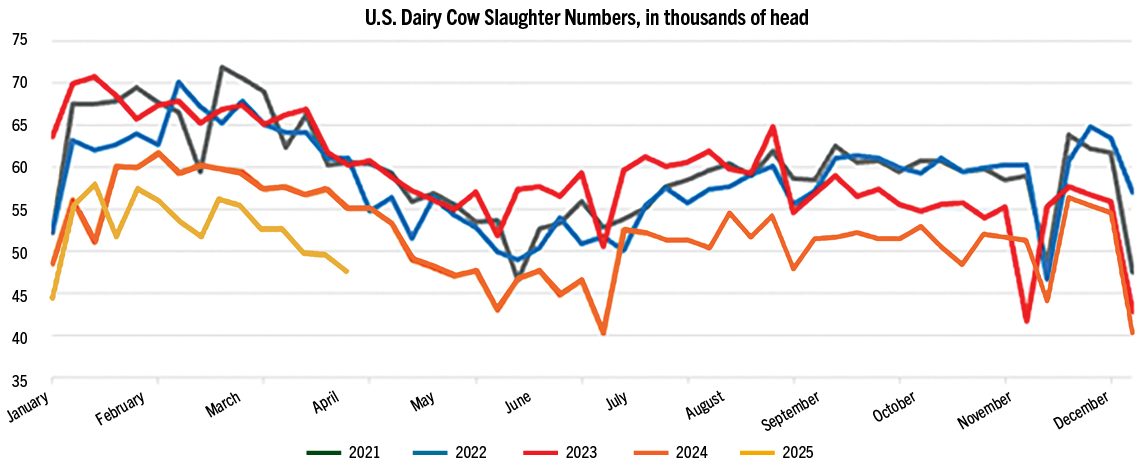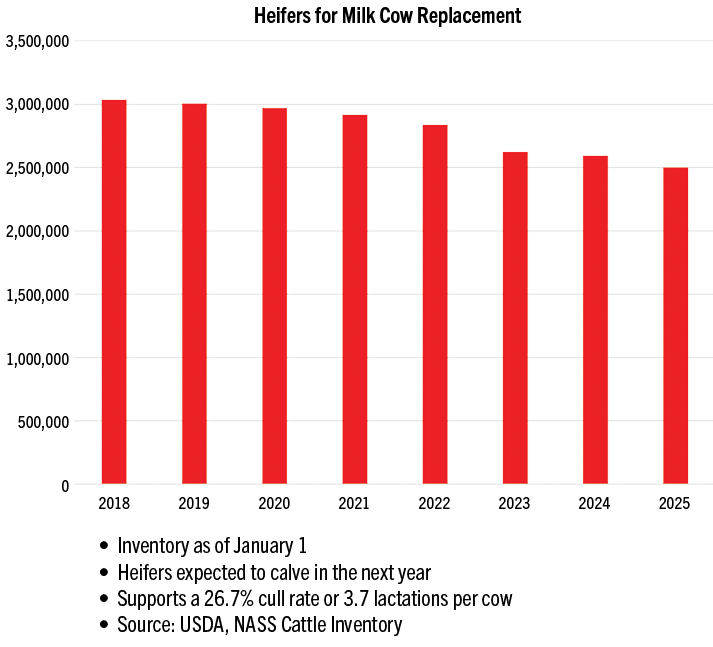The reduced heifer supply leaves herd owners with two options:
1. maintain current culling rates and reduce herd size
2. maintain and grow herd size through reduced culling rate
With demand for milk remaining strong, option two is the preferred choice for most dairies, and this is exactly what industry trends are showing. In 2024, we started to see reduced culling activity. The United States Department of Agriculture reports that there were 385,000 fewer dairy cows sent to slaughter in 2024 as compared to 2023. This trend continues in 2025 and early year totals indicate we could see a similar level of culling reduction in 2025.

What do these numbers mean at the individual herd level?
With the national herd at 9.4 million cows and an inventory of heifers due to calve in the next 12 months of 2.5 million, this means we have enough heifers to replace about 27% of the herd in 2025. This is substantially lower than typical culling rates in recent history. As each herd continues to adjust to reduced heifer supplies, we will likely see the national average culling rate go below 30% and move closer to 25%.
A key performance indicator often used to assess the age of the cow herd is the percentage of 3+ lactation cows. A standard benchmark has been to strive for 40% or more 3+ lactation cows. As herds move to culling rates below 30%, the herd makeup will need to move to 50-55% 3+ lactation cows.
So far, so good. In this early stage of adjusting to the reduced heifer supply, culling rates have been reduced, and herd size has been maintained without any serious downside. However, managing through 4-5 years of reduced culling is a significantly steeper challenge than just 1-2 years of reduced culling. After a year of reduced culling, the herd moves to a higher percentage of second and third lactation cows. With reduced culling over a longer stretch, the herd will need to maintain a higher percentage of fourth, fifth and sixth lactation cows.
Managing older cows presents different challenges than managing cows in their first and second lactation. As cows get older there is an increased incidence of mastitis, lameness and other health events. This leads to challenges in maintaining pregnancy rates and minimizing death loss.

For many of these same reasons, with a 27% cull rate, there will be limited opportunity for voluntary culling. A reduced culling environment means nearly every functional and pregnant first lactation cow is needed to fill out the second lactation group. The same situation exists for second lactation cows. Focusing on management and genetic improvements that will help reduce or minimize cows leaving the herd involuntarily is a key to effectively managing low culling rates.
Additional emphasis on traits like Somatic Cell Score, Mastitis Resistance, Lameness Resistance, Daughter Pregnancy Rate, Cow Conception Rate and Livability are things that should be considered when making today’s sire selection decisions. Striving for improvement in the traits cows will need to be good third and fourth lactation performers may be more critical than creating the best first lactation cows.
It appears this era of low dairy replacement heifer inventories will persist for some time - it may be the way we operate for the foreseeable future. Management and genetic improvement strategies need to adjust to these new circumstances.